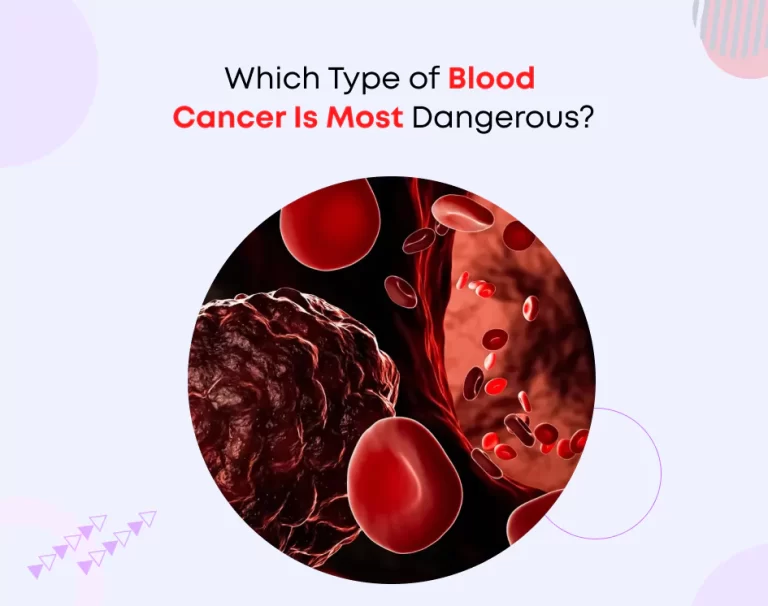
Which Type of Blood Cancer Is Most Dangerous?
Blood cancer is a broad term that includes several types of malignancies affecting the blood, bone marrow, and lymphatic system. These cancers disrupt the production and function of blood cells, often leading to severe health complications. Blood cancer primarily falls into three categories: leukemia, lymphoma, and myeloma. Each type has its own subtypes, symptoms, and treatment options.
Among these, certain forms are more aggressive and pose a greater threat to patients’ lives. This blog will explore the most dangerous type of blood cancer, examining its characteristics, symptoms, and treatment challenges. Understanding these aspects can help in early detection and more effective management of the disease.
Types of Blood Cancer
Blood cancer is primarily divided into three categories:
- Leukemia
- Lymphoma
- Myeloma
Each type has unique characteristics and affects the body differently.
Leukemia
Leukemia is a cancer that targets blood-forming tissues like the bone marrow. It causes an excessive production of abnormal white blood cells. This cancer is classified into four main types:
- Acute Lymphoblastic Leukemia (ALL): This type of leukemia progresses rapidly and affects lymphoid cells. It’s common in children but can also occur in adults.
- Acute Myeloid Leukemia (AML): AML progresses quickly and affects myeloid cells. It is more common in adults and can be difficult to treat.
- Chronic Lymphocytic Leukemia (CLL): This is a slow-growing leukemia that affects lymphoid cells. It’s common in older adults.
- Chronic Myeloid Leukemia (CML): CML progresses slowly and affects myeloid cells. It’s more common in adults and has targeted treatments available.
Leukemia can be life-threatening, especially in its acute forms, which require immediate treatment.
Lymphoma
Lymphoma is a cancer affecting the lymphatic system, which is a key part of the immune system. It affects the lymph nodes, spleen, and other organs. This one includes two main types:
- Hodgkin Lymphoma: This type is marked by the presence of Reed-Sternberg cells. It is very treatable, particularly if caught early.
- Non-Hodgkin Lymphoma (NHL): NHL includes a diverse group of blood cancers. Some subtypes are aggressive and require intensive treatment.
Lymphoma’s impact varies based on its type and stage. Early detection significantly boosts the likelihood of successful treatment.
Myeloma
Myeloma is a cancer of plasma cells (a type of white blood cell) in the bone marrow. It leads to an overproduction of abnormal plasma cells, primarily affecting the bone marrow.
- Multiple Myeloma: This is the most common type of myeloma. It causes bone pain, anemia, and kidney problems.
Myeloma can be managed with treatment, but it often recurs and requires ongoing therapy.
The Most Dangerous Type of Blood Cancer
Among the types of blood cancer, Acute Myeloid Leukemia (AML) is considered the most dangerous. This is due to its rapid progression and treatment challenges. Here’s why:
Characteristics of AML
AML is characterized by the rapid growth of abnormal myeloid cells in the bone marrow and blood. This results in a reduction of healthy blood cells. This cancer grows quickly, leading to severe health issues.
- Rapid Progression: AML progresses rapidly, causing a swift decline in health.
- High Relapse Rate: Even after successful treatment, AML often returns, making long-term remission difficult.
- Complex Treatment: Treatment involves intensive chemotherapy, which can be hard on the body, especially for older adults.
Symptoms of AML
The symptoms of AML are varied and often severe, affecting the overall health and quality of life of patients. The signs of this cancer can develop quickly and include:
- Fatigue and Weakness: Due to anemia caused by low red blood cell count.
- Frequent Infections: Resulting from a low white blood cell count, weakening the immune system.
- Easy Bruising and Bleeding: Due to a low platelet count, leading to clotting issues.
- Bone and Joint Pain: As cancer cells accumulate in the bone marrow.
- Weight Loss and Loss of Appetite: Common in many cancer types, affecting the patient’s nutrition and energy levels.
Diagnosis of AML
Diagnosing AML involves several tests:
- Blood Tests: To check for abnormal levels of white blood cells, red blood cells, and platelets.
- Bone Marrow Biopsy: To check the bone marrow for abnormal cell presence.
- Genetic Tests: To identify specific mutations that can affect treatment options.
Treatment Challenges for AML
Treating AML is complex and often requires aggressive approaches. Here they are:
Intensive Chemotherapy
Chemotherapy is the primary treatment for AML. It aims to destroy cancer cells but also affects healthy cells.
- Side Effects: Chemotherapy can cause severe side effects, including nausea, hair loss, and increased infection risk.
- Hospitalization: Patients often need to stay in the hospital during initial treatment for close monitoring and supportive care.
Stem Cell Transplant
A stem cell transplant can be a treatment option, especially for younger patients.
- Preparation: Involves high-dose chemotherapy to destroy cancer cells and the patient’s bone marrow.
- Donor Match: Requires a compatible donor, which can be a challenge.
Targeted Therapy
Newer treatments focus on targeting specific mutations in cancer cells.
- Personalized Medicine: Targeted therapy is tailored to the genetic makeup of the cancer, improving effectiveness.
- Fewer Side Effects: These treatments often have fewer side effects compared to traditional chemotherapy.
Prognosis and Survival Rates
The prognosis for AML varies based on several factors, including age, overall health, and specific genetic mutations.
Factors Influencing Prognosis
Age: Younger patients generally have better outcomes than older adults.
Genetic Mutations: Certain genetic changes in cancer cells can affect how well the cancer responds to treatment.
Overall Health: Patients in good health are better able to tolerate aggressive treatments.
Survival Rates
Five-Year Survival Rate: The overall five-year survival rate for AML is around 27%.
Continuous Monitoring: Regular follow-ups are crucial to detect any signs of relapse early.
Other Dangerous Blood Cancers
While AML is considered the most dangerous, other types of blood cancer can also be very severe:
- Acute Lymphoblastic Leukemia (ALL)
ALL is another aggressive form of leukemia, especially in adults. It advances rapidly and needs immediate treatment.
- Diffuse Large B-cell lymphoma (DLBCL)
DLBCL is a subtype of non-Hodgkin lymphoma. It is fast-growing and can be life-threatening without prompt treatment.
- Multiple Myeloma
Multiple myeloma can be very aggressive in certain cases. It causes significant damage to bones and kidneys, leading to severe complications.
Managing Blood Cancer
Early detection and treatment are crucial in managing blood cancer. Here are some general tips for managing blood cancer:
- Regular Check-Ups: Regular medical check-ups can help in the early detection of blood cancers.
- Healthy Lifestyle: Maintaining a healthy lifestyle with a balanced diet and regular exercise can boost the immune system and overall health.
- Awareness and Education: Being aware of the symptoms and risks associated with blood cancer can lead to early diagnosis and better outcomes.
Finishing Up
Among the various types of blood cancer, Acute Myeloid Leukemia (AML) stands out as the most dangerous due to its rapid progression and treatment complexity. While advancements in medical research have improved treatment options, AML remains a challenging disease with a high relapse rate. Early identification and prompt treatment are essential for improving outcomes.
Patients and caregivers should stay informed about the latest treatment options and engage in open communication with their healthcare team to navigate the challenges of this aggressive cancer. Knowing the severity and intricacies of AML can lead to better management and, ultimately, better patient outcomes.






